Statistical release: April to June 2021 (quarter 1, 2021 to 2022)
Updated 27 July 2022
Applies to England, Scotland and Wales
Housing Benefit (HB) is an income related benefit that is intended to help meet housing costs for rented accommodation.
This summary contains statistics on the average time taken (speed of processing) to process new HB claims and change of circumstances to existing HB claims. The average used is the mean and is measured in calendar days, rounded to the nearest day.
Annual data (covering the year up to each point) is included to illustrate the trend over time. Throughout this summary, this will be referred to as year-end figures and this is also measured in calendar days, rounded to the nearest day. So, for example, at quarter 1 2021 to 2022, the year-end figures would include the period from quarter 2 2020 to 2021, to quarter 1 2021 to 2022, as this covers a full one year.
1. Main stories
The main stories are:
-
during quarter 1 2021 to 2022, the average speed of processing for a new HB claim was 20 calendar days, which is two days higher than quarter 1 2020 to 2021. The average speed of processing for a change of circumstance to an existing HB claim during quarter 1 2021 to 2022 was 7 calendar days, which is two days higher than quarter 1 2020 to 2021
-
overall, the year-end volume of existing HB claims continues to decrease, and the year-end volume of new HB claims remains stable when compared with year-end figures from last quarter. However, the average speed of processing for a new HB claim at quarter 1 2021 to 2022 has continued to rise for the third consecutive quarter
-
at the Local Authority (LA) level, for quarter 1 2021 to 2022, LAs had an average speed of processing between 5 and 74 calendar days for new HB claims, and an average speed of processing between 1 and 49 calendar days for a change of circumstance to an existing HB claim
2. New HB claims and change of circumstances to existing HB claims
On average, LAs process a greater number of change of circumstances to existing HB claims than new HB claims. In quarter 1 2021 to 2022, 5% of claims processed in Great Britain (GB) were new HB claims and the remaining 95% were change of circumstances to existing HB claims.
Volume of HB Claims in GB, quarter 1 2021 to 2022
| Type of Claim | Number of Claims processed |
|---|---|
| New HB Claims | 86,000 |
| Change of Circumstances to existing HB Claims | 1,600,000 |
During quarter 1 2021 to 2022, there were 86,000 new HB claims and 1.6 million change of circumstances to existing HB claims processed in GB.
For new HB claims, there has been a decrease of 5,200 (6%) since last quarter and a decrease of 5,900 (6%) since quarter 1 2020 to 2021.
For change of circumstances to existing HB claims, there has been a decrease of 2.3 million (58%) since last quarter and a decrease of 860,000 (34%) since quarter 1 2020 to 2021. The decrease from quarter 4 2020 to 2021 to quarter 1 2021 to 2022 is consistent with that seen in previous years due to the annual uprating of rent at the end of the financial year.
The overall volume of change of circumstances to existing HB claims is continuing to decrease
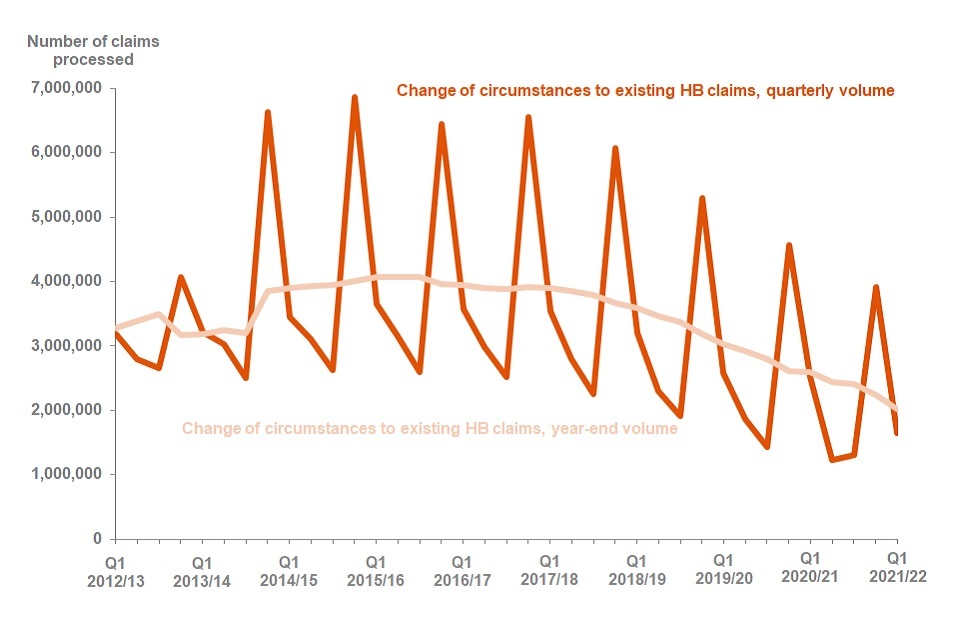
Overall year-end figures initially showed an increase in the volume of change of circumstances to existing HB claims, however, since quarter 2 2015 to 2016 (4.1 million), this volume has continued a downward trend to 2.0 million in quarter 1 2021 to 2022.
The volume of change of circumstances to existing HB claims decreased from 3.9 million at quarter 4 2020 to 2021 to 1.6 million at quarter 1 2021 to 2022. In quarter 4 each year, the volume of change of circumstances to existing HB claims increases sharply, due to the end of the financial year before the uprating of rent. The volume then decreases sharply after this in quarter 1 of the following financial year. This quarter continues that trend showing a 58% decrease in the volume of change of circumstances to existing HB claims compared to quarter 4 2020 to 2021.
The overall volume of new HB claims has remained stable in recent quarters
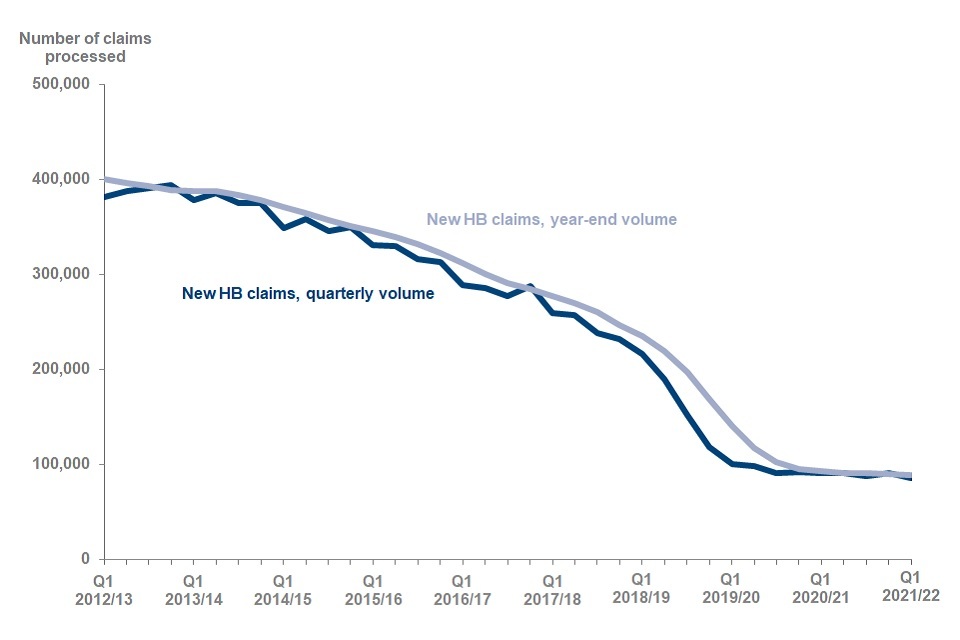
The overall volume of new HB claims peaked at 390,000 in quarter 4 2012 to 2013 and then decreased to 86,000 in quarter 1 2021 to 2022. This decreasing trend is also reflected in the year-end figures for new HB claims from 400,000 in quarter 1 2012 to 2013 to 89,000 in quarter 1 2021 to 2022. Since quarter 3 2019 to 2020, the volume of new HB claims has been stable.
The changes in volume of both new HB claims and change of circumstances to existing HB claims are due to the impact of the UC roll-out, which has also affected figures reported at the LA level. Both volumes are decreasing, however, at different rates, because of the change in the types of claims being processed. For example, changes to a claimant’s circumstances may lead to the claimant being moved to UC, however, there are a small number of people that are still able to apply for HB, including pensioners, whom have fewer changes to declare. Read about who can get Housing Benefit. It should be noted that care should be exercised when interpreting data at a LA level in the data tables accompanying this release.
At quarter 1 2021 to 2022:
- 95% of all HB claims processed in GB were change of circumstances to existing HB claims, compared to 96% at quarter 1 2020 to 2021
- 5% of all HB claims processed in GB were new HB claims, compared to 4% at quarter 1 2020 to 2021
The overall year-end proportion of new HB claims, compared to change of circumstances to existing HB claims, has remained stable
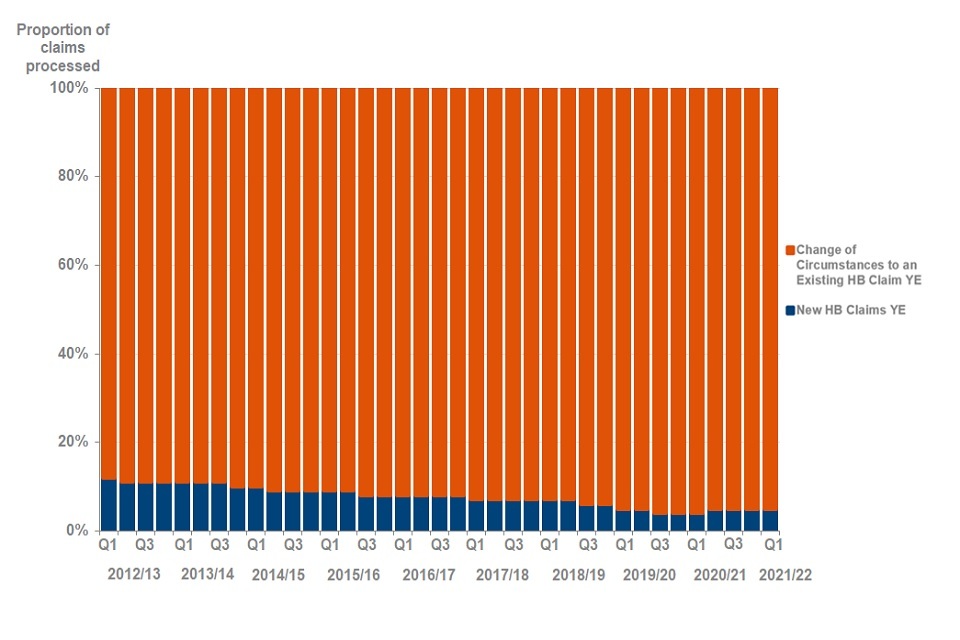
A greater number of change of circumstances to existing HB claims have been processed, compared with new HB claims in GB since 2011 to 2012. Using year-end figures to illustrate the trend over time, it can be seen that the proportion of change of circumstances to existing HB claims has continued to gradually increase from 88% in quarter 1 2012 to 2013 to 96% in quarter 1 2020 to 2021. Similarly, the proportion of new HB claims has gradually decreased from 12% in quarter 1 2012 to 2013 to 4% in quarter 1 2020 to 2021.
However, the most recent quarter has remained stable with the trend seen since the increase at quarter 2 2020 to 2021 as the proportion of year-end figures at quarter 1 2021 to 2022 remains:
- 95% of change of circumstances to existing HB claims, the same as the last three quarters
- 5% of new HB claims, the same as the last three quarters
This change in trend is driven by stability in the volume of year-end figures for new HB claims and the decreasing volume of year-end figures for change of circumstances to existing HB claims.
3. Average speed of processing
Quarterly year-end figures show the average speed of processing for new HB claims continues to increase
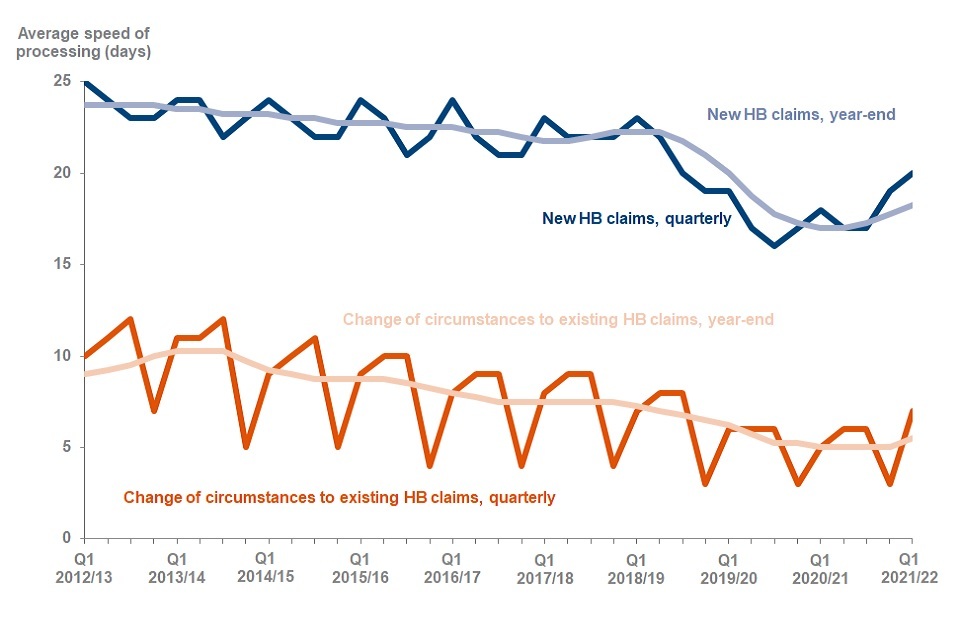
The average time taken to process a new HB claim during quarter 1 2021 to 2022 was 20 calendar days. This is two days higher than quarter 1 2020 to 2021 and one day higher than quarter 4 2020 to 2021.
The average number of days taken to process a change of circumstance to an existing HB claim, during quarter 1 2021 to 2022, was 7 calendar days. This is two days higher than quarter 1 2020 to 2021 and four days higher than quarter 4 2020 to 2021.
In quarter 4 each year, the volume of change of circumstances to existing HB claims increases, due to the end of the financial year before the uprating of rent. However, the average number of days to process those claims decreases because LAs tend to allocate extra resource to process these changes. In the other quarters, the volume of change of circumstances to existing HB claims decrease and have a higher average speed of processing.
No such seasonal pattern can be seen in the average number of days to process new HB claims.
Year-end figures peaked for new HB claims in quarter 1 2012 to 2013, with an average of 24 calendar days to process and continued to steadily decrease until quarter 4 2018 to 2019 with an average of 21 calendar days to process. Since then, the average number of calendar days to process has decreased more quickly to an average of 17 calendar days to process a new HB claim in quarter 4 2019 to 2020, where it remained to quarter 3 2020 to 2021. However, since quarter 4 2020 to 2021, the average speed of processing to process a new HB claim has increased to 18 calendar days at year-end. This is due to the impact of the roll out of UC, as fewer people are now able to open a new HB claim. Read about who can get Housing Benefit.
Year-end figures for change of circumstances to existing HB claims peaked in quarter 1 2013 to 2014 with an average of 10 days to process. This steadily continued to decrease to an average of 5 days at year-end for the period of quarter 3 2019 to 2020 to quarter 4 2020 to 2021. However, this quarter sees an increase in the average speed of processing for change of circumstances to existing HB claims at year-end to 6 calendar days.
Monthly year-end figures show an increase in the average number of days to process new HB claims
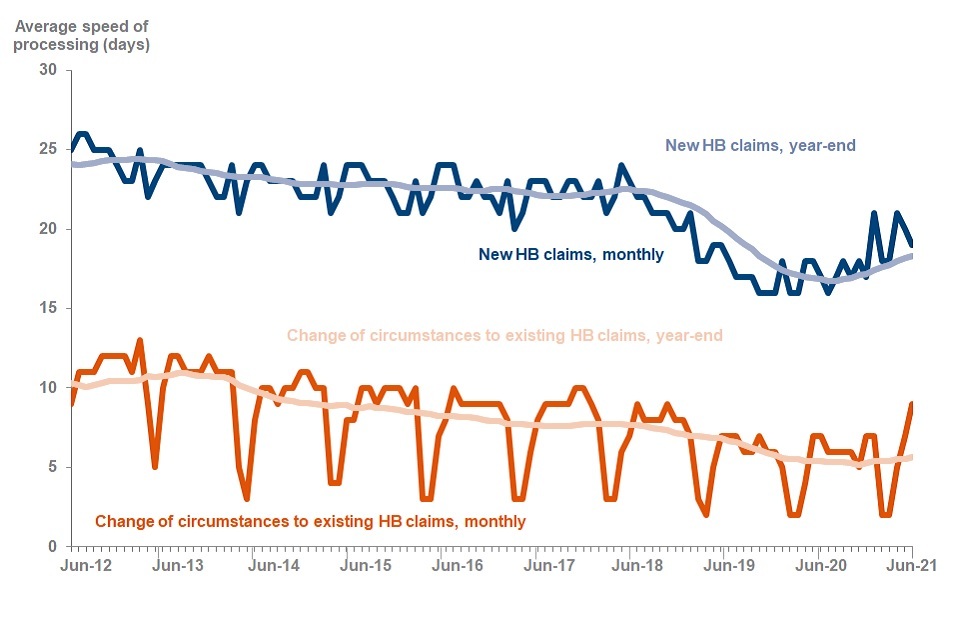
In quarter 1 2021 to 2022, the monthly average number of calendar days to process new HB claims was:
- 21 calendar days for April
- 20 calendar days for May
- 19 calendar days for June
The peak in the monthly average number of calendar days to process new HB claims was 26 calendar days in June 2012. The average number of calendar days to process new HB claims ranged between 26 and 20 calendar days up until January 2019. From February 2019 to December 2020, the average number of calendar days to process new HB claims ranged between 19 and 16 calendar days. Since January 2021, the average number of calendar days to process new HB claims ranged between 21 and 19 calendar days.
Year-end figures for the monthly average number of calendar days to process new HB claims have decreased steadily from an average of 24 calendar days to process a new HB claim in June 2012, to an average of 22 calendar days to process a new HB claim in January 2019. Since then, the monthly average number of calendar days to process decreased more quickly to an average of 17 calendar days to process a new HB claim in July 2020. However, since August 2020, the average number of calendar days to process new HB claims has continued to steadily increase to 18 calendar days, at year-end, in June 2021.
The monthly average number of calendar days to process change of circumstances to existing HB claims during quarter 1 2021 to 2022 was:
- 5 calendar days for April
- 7 calendar days for May
- 9 calendar days for June
The peak in the monthly average number of calendar days to process change of circumstances to existing HB claims was 13 calendar days in January 2013. Whilst the lowest monthly average number of calendar days to process change of circumstances to existing HB claims was 2 calendar days, seen for the first time in March 2019 and most recently at March 2021. This is at the end of the financial year before the uprating of rent, when LAs tend to allocate extra resources to process change of circumstances to existing HB claims from tenants. This quarter sees a continued increase in the monthly average number of calendar days to process change of circumstances to existing HB claims to 9 calendar days at June 2021.
Year-end figures for the monthly average number of calendar days to process change of circumstances to existing HB claims have decreased gradually over time. In January 2013, the year-end figure for the average time to process change of circumstances to existing HB claims was 11 calendar days, compared with 5 calendar days in April 2020. Since November 2020, the monthly average number of days to process change of circumstances to existing HB claims has continued to increase at year-end to 6 calendar days at June 2021.
4. Average speed of processing by LA
Quarterly average number of days to process new HB claims and change of circumstances to existing HB claims can be illustrated at the LA level for GB, for a more detailed breakdown see table 1 of the data tables accompanying this release.
The average number of days to process change of circumstances to existing HB claims varies by LA across GB
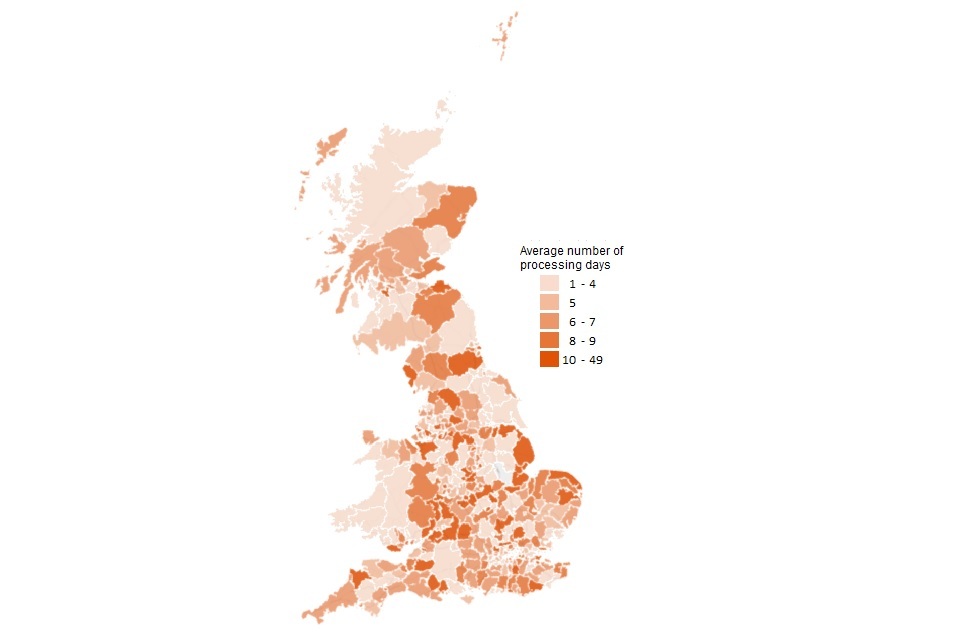
The quarterly average number of days to process change of circumstances to existing HB claims at the LA level ranged from 1 calendar day to 49 calendar days during quarter 1 2021 to 2022. 80% (299) of LAs had a quarterly average number of days to process change of circumstances to existing HB claims of 1 to 9 calendar days while almost the remaining 20% (74) of LAs took on average between 10 and 22 calendar days to process change of circumstances to existing HB claims during the quarter. Two LAs had average speed of processing times of 27 and 49 calendar days to process a change of circumstances to an existing HB claim. This was due to technical issues with IT and an increase in staff training requirements, which caused large backlogs. DWP Local Authority Partnership, Engagement and Delivery (LA-PED) colleagues continue to support these LAs.
The average number of days to process new HB claims varies by LA across GB

On average a new HB claim takes longer to process than a change of circumstance to an existing HB claim. Detailed figures in the accompanying tables show greater variability for new HB claims in comparison to change of circumstances to existing HB claims.
The quarterly average number of days to process new HB claims at the LA level ranged from 5 to 74 calendar days during quarter 1 2021 to 2022. 80% (302) of LAs had a quarterly average number of days to process new HB claims of 5 to 25 calendar days while almost the remaining 20% (70) of LAs took on average between 26 and 50 calendar days to process new HB claims during the quarter. Three LAs had average speed of processing times between 63 to 74 calendar days to process a new HB claim. This was due to technical issues processing new claims, an increase in staff absences, and staff training requirements which caused large backlogs. LA-PED colleagues will continue to support these LAs.
Variations between the average number of days that each LA takes to process a new HB claim or a change of circumstance to an existing HB claim should be seen in context with changes to operational processes, including reallocating resource due to impacts of the COVID-19 pandemic.
5. COVID-19
This summary contains statistics on the number of new HB claims, and change of circumstances to existing HB claims, for the period from April to June 2021.
The data in this release should be seen in context with operational emergency measures, policy changes and easements due to the COVID-19 pandemic:
Local Housing Allowance
Local Housing Allowance (LHA) rates determine the financial support renters in the private sector are entitled to. LHA rates were increased in response to COVID-19. In April 2020 they were set at the 30th percentile of rents within the local area for each bedroom size up to a maximum of 4 bedrooms. From April 2021 rates have been maintained at their increased levels in cash terms.
Working Tax Credit
The Additional Earnings Disregard (AED) for HB increased by £20 per week in the 2020 to 2021 tax year in response to the COVID-19 pandemic. Working Tax Credit (WTC) entitlement has changed for the 2021 to 2022 tax year and the AED increase of £20 is no longer in effect.
A one-off lump sum payment of £500 has been paid to WTC recipients in the 2021 to 2022 tax year. This was disregarded for HB claimants.
Easements
Easements have been put in place to support LAs during the COVID-19 pandemic in order for them to continue effective delivery of HB services.
6. What you need to know
National, Official and Experimental Statistics are produced in accordance with the Statistics and Registration Service Act 2007 and the Read the Code of Practice for Statistics. This release contains Official Statistics on speed of processing of HB claims for quarter 4, 2020 to 2021. They are compiled following the standards of trustworthiness, quality and public value set out within the Code.
The statistics are released quarterly in April, July, October and January and are sourced from data originally collected via administrative systems, the Single Housing Benefit Extract.
The statistics show speed of processing of new HB claims and change of circumstances to existing HB claims. The volume of new HB claims and change of circumstances to existing HB claims are also included here for context. The total days to process are included in supporting detailed tables that can be viewed in the HB: Statistics on speed of processing collection page including a breakdown at LA level.
Genuine variations between months can occur at a LA level. For example, some of these are caused by time limited issues or localised changes in operational policy. Hence, figures for individual LAs should be interpreted with care.
Quarterly and annual totals may not be entirely consistent with monthly figures. This is because any LAs that do not have data for every month of the quarter or year are not included in the quarterly or annual breakdowns. Year-end figures include data over the previous 12 months, but there may be inconsistencies where LAs do not have available data for the period.
From April 2013, UC was introduced. Read more about UC. The process began with single claimants and was expanded to other claimant types via the UC Full Service (UCFS). The UCFS rollout was completed in December 2018 and it is now available in every Jobcentre across the UK. Read the rollout schedule for Full Service. UCFS implementation dates for each LA are provided in the supporting tables for this release.
As stated in previous releases, HB datasets do not include figures for Hackney LA from October 2020, as a result of a cyber-attack suffered by the LA impacting data provision. These data problems are unlikely to be fixed until late into 2021. Therefore, Speed of Processing figures for Hackney will be omitted, in line with our standard approach for handling missing data. Analysis for Hackney using historical data shows that this is likely to affect volumes of HB claims by 1% at GB level and around 5% at regional (London) level. The GB and regional Speed of Processing figures are not impacted by the omission of Hackney data.
7. Where to find out more
Historical data
The historical Housing Benefit and Council Tax Benefit Claims Administration Quarterly Performance Data which is available from 2007 to 2008 are based on clerical returns made by individual LAs. Breakdowns of New HB Claims and Change of Circumstances to existing HB Claims Speed of Processing are available historically, and the New HB Claims Speed of Processing are broadly comparable over time. However, a change in definition for Change of Circumstances to existing HB Claims between 2007 to 2008 and 2009 to 2010 means that direct comparison of this element with Speed of Processing statistics is not meaningful.
Read the background information and frequently asked questions on statistics for the average time taken to process HB (previously right time indicator statistics) on statistics for the average time taken to process HB Claims (previously right time indicator).
Read the Department for Work and Pensions (DWP) statistical summary policies and statements for information about policies and procedures on DWP National and Official Statistics, including a Quality Guideline, Confidentiality and Access Policy Statement, Pre-release Access arrangements and Statement of Administrative Sources.
Other National and Official Statistics
The Department for Work and Pensions (DWP) also publish the HB Caseload National Statistics that have been used in this release. The statistics are published quarterly showing monthly caseload figures which are measured on a claimant basis. Full statistics on HB caseload since August 2013 are available from Stat-Xplore and Excel. The latest figures for HB caseload available in the Excel tables is May 2018.
Read details of other National and Official Statistics produced by the DWP.
Feedback
DWP welcomes feedback on all the statistical publications as it ensures that publications remain relevant to the users. Please use the HB Speed of Processing questionnaire to send us any specific feedback that you may have on this publication. DWP will use the information to:
- target future consultations at interested users
- shape the future direction of statistics development to address user needs; help ensure value for money, whilst giving users a structured way of expressing their views
Completed questionnaires can be returned by e-mail to stats-consultation@dwp.gov.uk or by post to the following address:
Client Statistics Team,
Data as Statistics,
Department for Work and Pensions,
Room BP5201,
Benton Park Road,
Longbenton,
Newcastle upon Tyne,
NE98 1YX
Users can also join the Stats UserNet “Welfare and Benefit Statistics” community. DWP announces items of interest to users via this forum, as well as replying to users’ questions.
Press enquiries should be directed to the DWP Press Office, telephone: 0203 267 5144.
Other enquiries about these statistics should be directed by email to:
Producer of this release: james.gray9@dwp.gov.uk
Lead statistician: lee.mcgargill1@dwp.gov.uk
ISBN: 978-1-78659-364-1
